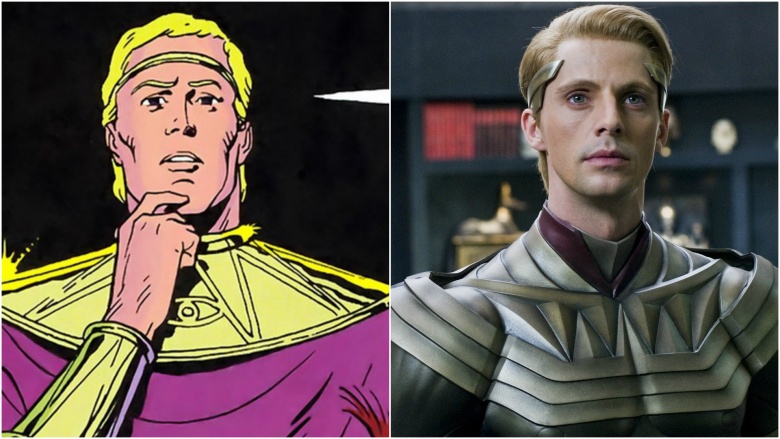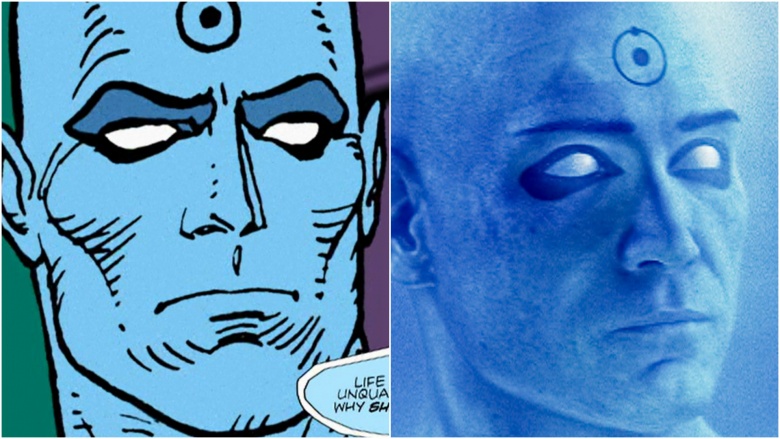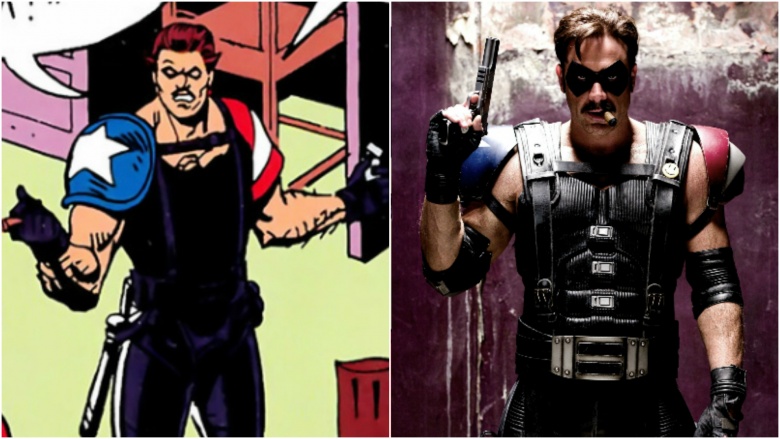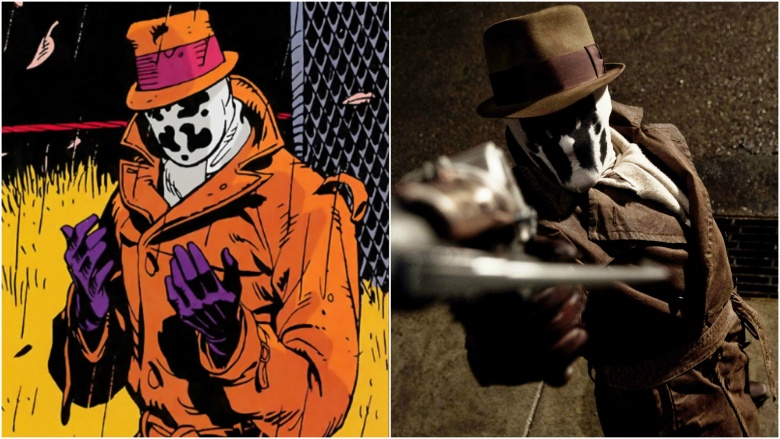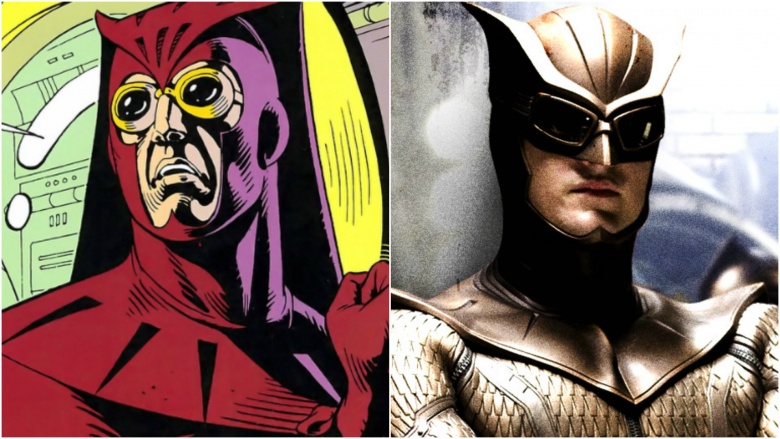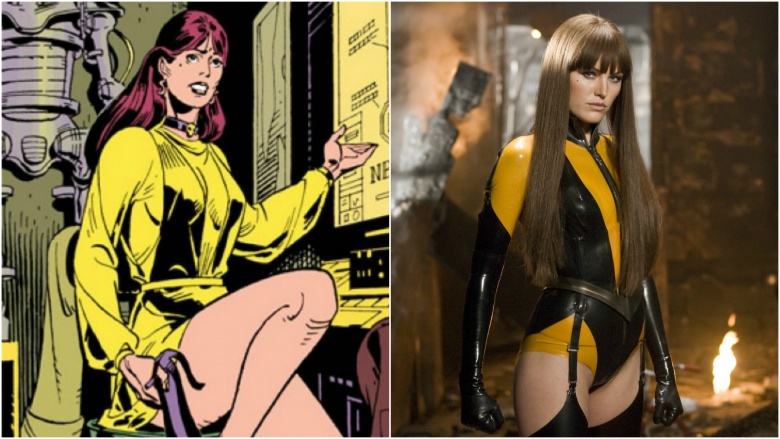How The Watchmen Should Really Look
After the silly Silver Age of Comics, the funny books started to grow up during the Bronze Age, testing the water with depictions of real-world concerns such as racism and drug abuse. Then with Alan Moore and Dave Gibbons' 1987 graphic novel Watchmen, the Bronze Age ended and the Dark Age (or Modern Age) began.
Publishers looked outside traditional forms of storytelling with heroes always facing the villain. Instead, stories began to focus on character deconstructionism, existentialism, and metaphysics. Watchmen was the impetus for this movement, which is why it's listed as one of the 100 best English novels of the past century.
Warner Bros. released Zack Snyder's theatrical adaptation of the iconic graphic novel in 2009, and while the film remains largely faithful to the source material, the director couldn't help but make some changes. There are more than a few changes (the ending is a big one), but some of the most obvious alterations are the costumes and looks of the characters. Snyder had a challenging task bringing these designs to live action, and though he largely nailed the look of the comic, there are some differences. So here's how the Watchmen should really look.
Ozymandias
Adrian Veidt, played by Matthew Goode, is both the hero and villain of the story. He was once a member of the Watchmen before deciding to orchestrate a type of world peace through mutually-experienced destruction. By uniting the nations of the world against a common enemy, Doctor Manhattan, Veidt was trying to negate the purpose of having costumed heroes at all. To not only create but carry out such a treacherous plan — one that remained secret to all the other Watchmen, including Doctor Manhattan — required the skills of a mastermind, which is exactly what Veidt is. In the comic he's considered the "smartest man on the planet."
Veidt attributes his need for saving the world from a nuclear holocaust to what Alexander the Great did centuries before him, joining the known world under one empire. Since he perceived Alexander to be similar to that of Egyptian pharaoh Ramesses II, he opted to become more like the latter. That is why Veidt's superhero costume is heavily evocative of Egyptian royalty with long, purple garb with gold plating (which he derives from his fascination with Ramesses). That's also how he got his superhero alias: Ozymandias is the Greek name for Ramesses II.
While parts of Veidt's love and admiration for Egyptian royalty continued over to the silver screen in Snyder's film, his purple-and-gold costume did not. Instead, the production team decided to take some cues from the superhero costumes of the '80s and '90s (including its own version of those infamous Bat-nipples). Snyder told Collider in 2008. "If you think the fact that Ozy's costume has nipples is a mistake, or that we don't understand the design, then to me that's crazy."
Doctor Manhattan
Rorschach may narrate the story, but it's Doctor Manhattan who is truly at the heart of the narrative. Former nuclear physicist Dr. Jonathan Osterman, played by Billy Crudup (who did both the voice and motion-capture for the character), is disintegrated after accidentally locking himself inside the Intrinsic Field Subtractor room. The process transformed him into the supreme being Doctor Manhattan, giving him god-like powers.
It also altered his physical appearance. While he maintained a humanoid form, his body morphed into what is commonly referred to as the "muscle man" — a seemingly perfect male physique — having a tall stature and defined muscles. It also gave him his signature blue complexion. Other than that, Doctor Manhattan's other defining characteristic is the symbol of a hydrogen atom that he etched on his forehead, representing his closeness to atoms.
Getting Doctor Manhattan's appearance right on the big screen arguably required the most effort, since his entire presence is CGI. Doctor Manhattan wore a black leotard during his early days with the Watchmen in the comic. Over time his costume shrank to nothing more than a black thong. Eventually, he stopped wearing clothes at all unless he was in public. Interestingly, the VFX team based the character's body on the physique of actor and model Greg Plitt. In the film, they stick pretty close to the comic design (all the way down to the nakedness).
The Comedian
After the Keene Act of 1977 banned costumed heroes, Edward Morgan Blake, aka The Comedian, and Doctor Manhattan became the only two government-approved superheroes thanks to their participation in the Vietnam War. In 1985, Ozymandias kills The Comedian for accidentally uncovering his nefarious plan to destroy New York City. Although he is not the central character, and only appears in flashback sequences, Blake's death is what prompts Rorschach's investigation in the first place.
In those flashbacks we see The Comedian, played by Jeffrey Dean Morgan, wear his all-American costume: a black leather outfit with a white-and-blue star on his right shoulder, and red-and-white stripes on his left. Then there's The Comedian's badge — the yellow smiley face — which has become the iconic symbol of the Watchmen. According to Dave Gibbons, in Watching the Watchmen: The Definitive Companion to the Ultimate Graphic Novel, The Comedian's costume was originally going to be more militaristic, outfitted with more armor and less leather.
Although Gibbons didn't go with the militaristic design for the character in the comic, Snyder chose to incorporate the idea in the movie. The Comedian's on-screen costume, although still leathery, was more armored and had an ammo belt going over his shoulder. His shoulder pads remained the same from the comic, though they occasionally appear darker in the movie, almost non-existent. But in other scenes, they appear as bright and prominent as they are in the novel. Overall, The Comedian's costume remained mostly the same, with a few distinct differences along the way.
Rorschach
He's arguably the least powerful character in the film, but this is Rorschach's story. Rorschach, aka Walter Joseph Kovacs, not only narrates Watchmen via his journal entries but moves it forward through his investigation and his affairs with former Watchmen members. Along with Doctor Manhattan, Rorschach's appearance also remains virtually unchanged in the film adaptation.
In the comics, when Kovacs is in his civilian attire, he appears to be homeless. He wears raggedy clothing and holds up a "The End Is Nigh" sign. When he suits up he wears a purple business suit, brown overcoat, grey scarf, Rorschach inkblot mask, and a fedora hat — all of which carried over to the silver screen in Snyder's adaptation. The only keen difference between the comic and film characterizations is that Jackie Earle-Haley, who plays Rorschach, is right-handed, whereas the character is left-handed in the novel. Aside from that, his costume, along with his dialogue and characterization, makes him the most comic-accurate character in the movie.
Nite Owl
While the majority of superheroes in Watchmen are the first to take up their names, Daniel Dreiberg (played by Patrick Wilson) was not the first Nite Owl. It was only after the first Nite Owl, Hollis T. Mason, retired that Dreiberg sought him out and asked permission to take up his mantle. Dreiberg then became a member of the Watchmen, the successors to the Minutemen, which Mason was a member.
Unlike Mason's Nite Owl, Dreiberg's took heavy inspiration from Batman and Blue Beetle, relying more on his gadgets than his brute strength. We see those nods throughout the graphic novel, but Snyder wanted it to be ever more prevalent when it came to his film adaptation. Instead of keeping the character's rich, reddish-brown cape and cowl, the production team designed a costume reminiscent of modern superhero movies. The big screen Nite Owl is outfitted with a heavy-plated, Batman-esque armor made out of chain-mail.
As for why the production team took so many liberties with Nite Owl's design, Snyder told fans in a Q&A, "The costumes, as they're drawn [in the novel], might not be accessible to many of today's audiences. I also felt that audiences might not appreciate the naiveté of the original costumes."
Silk Spectre
Nite Owl wasn't the only hero to receive significant changes to his costume. Silk Spectre — specifically the second Silk Spectre, Laurie Juspeczyk, played by Malin Akerman — was another character considerably altered by Snyder and the design team. Similar to other Watchmen characters, Alan Moore drew inspiration from DC Comics characters for Silk Spectre, like Phantom Lady and Black Canary. However, her primary inspiration came from Nightshade, whose relationship with Captain Atom served as the basis for Silk Spectre's relationship with Doctor Manhattan.
While most of her characterization and relationships carried over to the big screen, her costume changed quite a bit. Not in terms of design, but rather in terms of styling. Silk Spectre's costume in the graphic novel represented the clothing trends of the '80s, as she wore a yellow-and-black short dress-like costume. She carried the color scheme over from her mother, the original Silk Spectre — which didn't change in the movie. However, instead of wearing a loose costume, Akerman's Silk Spectre wore skintight spandex.
As one can imagine, it wasn't exactly comfortable for Akerman, who reportedly hated wearing it. "I thought it was really f***ing hot (at first). Then I tried it on, and I thought it was really f***ing uncomfortable," Akerman told Maxim (via Celebuzz). Well, she wouldn't be the first or the last person to hate her superhero costume.

